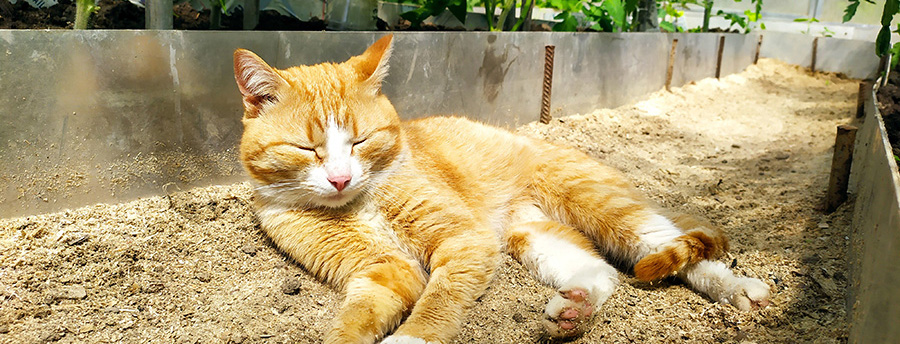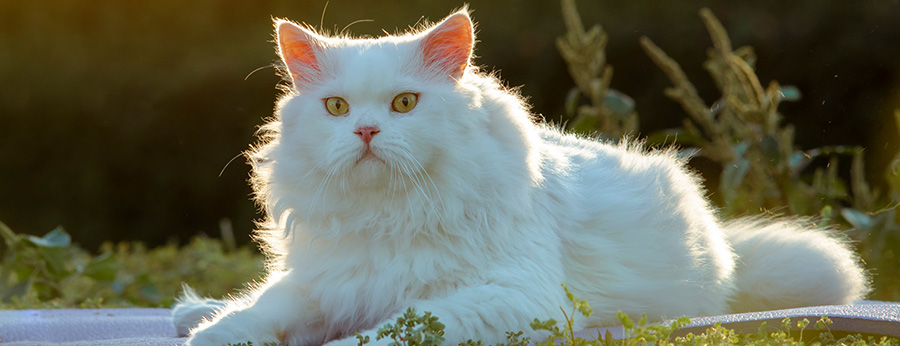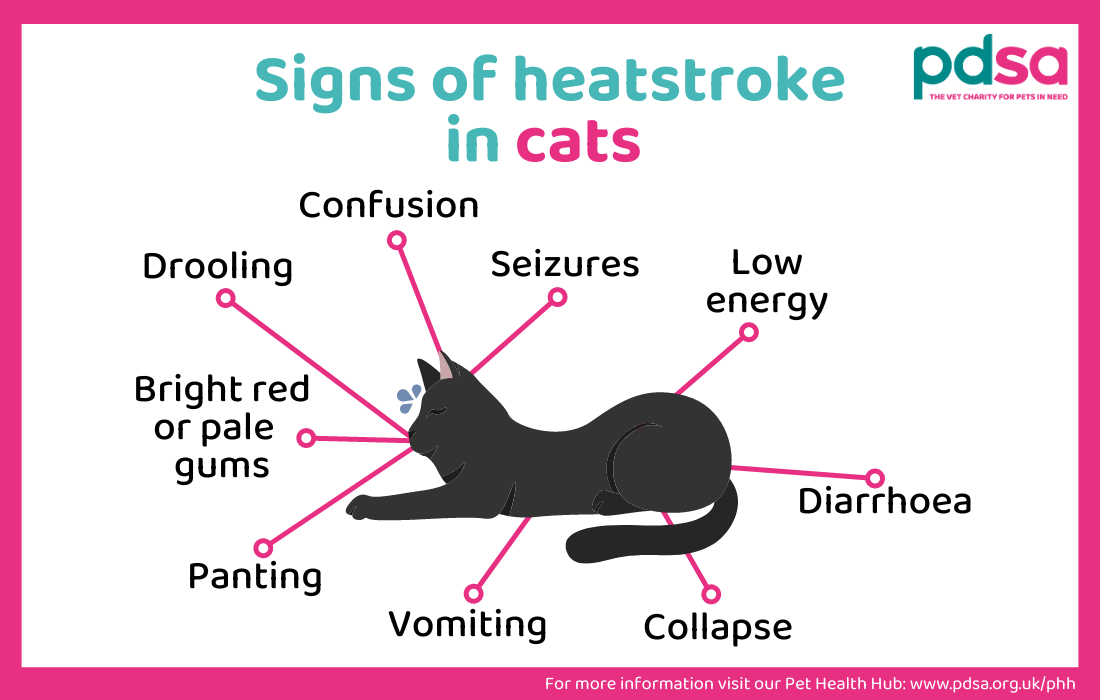Heatstroke in cats
Overview
- Heatstroke is a very serious condition that can cause severe dehydration, organ damage and death.
- The most common cause of heat stroke in cats is being accidentally trapped in a hot, poorly ventilated space such as a shed, greenhouse, conservatory, or garage.
- If your cat is showing symptoms of heatstroke, start cooling them down immediately, then contact your vet.
- The quicker your cat is cooled down the better their chance of recovery.
- Obese, long-haired, old, young and brachycephalic/flat-faced cats (such as Persians) are most at risk of developing heatstroke because they find it harder to cool down.
First aid for heatstroke in cats
The faster your cat is cooled down, the better their chance of a full recovery, so act quickly but stay calm.
Step 1: Move your cat indoors to a cool room or into the shade
Step 2: Start cooling your cat straight away
- Slowly pour cold water (water from the cold tap is fine) over their whole body, most cats don’t like being wet so be very gentle
- Be extremely careful they don’t inhale any water by keeping it away from their nose and mouth
- Create a breeze by turning a fan on, or opening doors and windows
- Offer them a drink of cold water but do not force them to drink
- Put them on top of a cold, soaking wet towel
- Don’t cuddle them or cover them with a wet towel as this can make them even hotter
- Wrap an ice pack or a bag of frozen veg in a tea-towel and place in in between their legs
Step 3: Call your vet as soon as possible
- Ideally go to your nearest vets
- Transport your cat in a car with the air-conditioning on, or with the windows open (but make sure they aren’t able to escape)
- If possible bring someone with you to keep cooling your cat while your travel

Heatstroke is a very serious condition that can develop if your cat’s body temperature becomes dangerously high. Normal body temperature for a cat ranges between 38.1-39.2°C (100.5-102.5°F), this can get a bit higher if they have a fever from being unwell. However, if your cat’s body temperature goes above 40°C/104°F they are at risk of heatstroke, which can cause severe dehydration, seizures, blood clotting problems, organ damage, coma and death. Heatstroke is more dangerous the longer their body temperature stays high, so the quicker they are cooled down and treated by a vet, the better their chance of a full recovery.

Cats have a very limited ability to sweat, so instead, they control their temperature by licking themselves and seeking shade on warm days. However, cats also love finding a warm place to sleep, which is why most cases of heatstroke develop after being accidentally shut in a hot place such as a shed, greenhouse, conservatory, garage, or car. Unlike dogs, it’s very unusual for cats to develop heatstroke due to overexerting themselves during exercise.

Yes. Any cat can get heatstroke, but some are more at risk, such as:
- Cats with long coats
- Obese cats
- Brachycephalic (flat-faced) cats, such as Persians
- Very old cats and very young kittens – they aren’t as good at regulating their body temperature
- Cats with heart and lung disease
Treatment
Cooling
Your vet will start cooling your cat as quickly as possible using water, fans, ice packs, and possibly a fluid drip. If they are extremely hot, struggling to breathe, having seizures or are unconscious, your vet may also use anaesthesia, oxygen and other medications. The faster your cat is cooled down, the better their chance of recovery.
Blood tests
Severe heatstroke can cause kidney damage and blood clotting problems, so depending on how poorly your cat is, they may also need blood and urine tests. If the tests show signs of a problem, it’s likely that your cat will need to stay in the veterinary hospital for a few days for intensive treatment and further tests.
Nursing
Your cat will be closely monitored and nursed carefully until they are stable. Once your vet is happy for them to go home, you will need to watch them closely and let your vet know straight away if they deteriorate or develop symptoms such as vomiting, diarrhoea, confusion, increased thirst, or reduced appetite.
Check-ups
It’s likely that your cat will need a check-up a few days after they are discharged to ensure they are recovering well, and possibly blood/urine tests to check their vital organs. Your vet may ask you to bring a urine sample from home – watch our video on how to collect a urine sample from your cat.
Outlook
The quicker a cat with heatstroke is cooled and taken to a vet, the better their chances of a full recovery. If your cat develops a mild case of heatstroke and is treated quickly, they are likely to make a full recovery. If they overheat for a long time, or treatment is delayed, they are likely to become seriously unwell, develop organ damage and could even die.

There are some simple things that you can do to prevent your cat from developing heatstroke:
- Make sure they have access to shade and water at all times
- Always check sheds, greenhouses, conservatories and cars before shutting them
- Never leave them in a hot room or somewhere with poor ventilation
- Never leave them in a car on a warm day – not even for a few minutes or with the windows open
- Avoid travelling with your cat when it’s hot – it’s unusual to take a cat out in the car, but if you need to make an essential trip, make sure your cat has air flowing around them and is a comfortable temperature, especially if they are prone to stress
- Keep them a healthy weight – overweight cats find it much more difficult to stay cool on warm days
Heatstroke in brachycephalic (flat-faced) cats
Cats get rid of significant amounts of body heat through their nose as they breathe out. Brachycephalic (flat-faced) cats such as Persians, struggle to release heat this way because they have much less space inside their nose. This puts them at a much higher risk of heatstroke, even on seemingly cool days.
Cost
Emergency treatment for a poorly pet can be expensive.
When you welcome a new cat into your life, consider getting cat insurance straight away before any signs of illness start. This will give you peace of mind that you have some financial support if they ever get sick.
Published: September 2023
Did you find this page useful?
Tell us more
Please note, our vets and nurses are unable to respond to questions via this form. If you are concerned about your pet’s health, please contact your vet directly.
Thank you for your feedback
Want to hear more about PDSA and get pet care tips from our vet experts?
Sign up to our e-newsletter
Written by vets and vet nurses. This advice is for UK pets only. Illustrations by Samantha Elmhurst.


